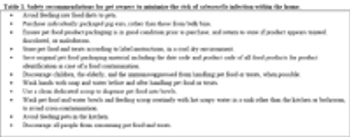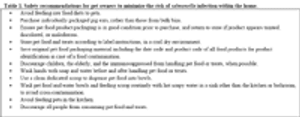
We have a positive cryptococcus on this cat 7-20-10. Chem normal except glob 6.8 and alb 2.1., wbc 27,820. Primarily granulocytes, dec lynphycytes. Rbc 7,420 mild dehydration. Faint positive leukemia neg fiv.

We have a positive cryptococcus on this cat 7-20-10. Chem normal except glob 6.8 and alb 2.1., wbc 27,820. Primarily granulocytes, dec lynphycytes. Rbc 7,420 mild dehydration. Faint positive leukemia neg fiv.

Multiple recalls of commercial pet food, treats, and supplements have occurred in the United States in the past several years, on account of potential contamination with Salmonella.

The mammalian GI tract is sterile during fetal development, and the fetus is originally exposed to bacteria during passage through the birth canal. Bacteria are ingested from the local environment and travel through the GI tract, competing with other bacteria and ultimately colonizing in their ideal niche.

Canine parvovirus 1 was first isolated from the feces of military dogs in 1967. It was named for its small size (18-26nm), from the Latin word parvus, meaning small. Initially, canine parvovirus 1 was thought to be nonpathogenic; however it can cause gastrointestinal disease, pneumonia, and myocarditis in young pups.

The large intestine is comprised of the colon, cecum, rectum, and anal canal, and in dogs and cats comprises roughly one quarter of the total intestinal length. The colon includes the ascending, transverse, and descending components.

The canine esophagus is a complex structure comprised of two layers of oblique skeletal muscle traversing the thorax from the upper esophageal sphincter in the pharynx to the lower esophageal sphincter entering the stomach.

The gallbladder is a thin-walled, muscular tear-dropped shaped sac that lies on the visceral surface of the liver, between the quadrate lobe and the right medial lobe. The gallbladder consists of a fundus, body, and neck, which opens into the cystic duct. The cystic duct then empties into the common bile duct which travels to the duodenum, ending in the major duodenal papilla.

When a new pet is acquired, numerous factors become part of the owner's decision of which diet to select. A pet owner may consider feeding advice from family, friends, the pet's breeder, trainer, or their local veterinarian. The internet has also become a large available source of information for pet owners regarding feeding options and other health issues for pets.

Small animal veterinarians prevent, diagnose, and treat parasitic infections every day, and most veterinarians are very comfortable managing these infections in their patients. However, when it comes to the zoonotic potential of parasitic organisms, it is challenging to keep up with new research, client questions can become tougher, and there becomes a fine line between educating a client about realistic risk and inducing unnecessary fear.

Published: August 1st 2011 | Updated:

Published: August 1st 2011 | Updated:

Published: August 1st 2011 | Updated:

Published: August 1st 2011 | Updated:

Published: August 1st 2011 | Updated:

Published: August 1st 2011 | Updated: